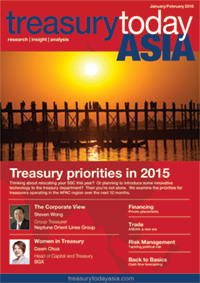Contents
- Editorial
- Mobilising the APAC markets
- Women in Treasury
- Women in Treasury - Dawn Chua, SGX
- Question Answered
- Best practice: IPOs
- Insight & Analysis
- APAC treasury in 2015: all change?
- Financing
- The world of private placements
- Know the Institution
- In SAFE hands
- The Corporate View
- Corporate View: Steven Wong, Neptune Orient Lines Group
- Risk Management
- Political risk: the impact on corporates
- Trade
- The new trade paradigm in ASEAN
- Adam Smith Awards Asia
- Adam Smith Awards 2021
- Back to Basics
- Peak flow
- Point of View
- Cash management: best practice (part one)
Editorial
Mobilising the APAC markets
The ascent of mobile is arguably the greatest innovation that the payments industry has seen in recent memory. Nowhere does the mobile revolution hold more promise than in Asia. After all, the region accounts for over half of the world’s mobile devices. There is also a significant move towards m-commerce in APAC, with over 50% of all Asia-based online transactions in 2015 set to be made by mobile, according to Criteo.
Yet, as we frequently see in the region, there is great disparity between individual nations. This is not only as a result of varying levels of smartphone penetration, but also because of payment infrastructure challenges in rapidly growing markets, as well as certain cultural barriers.
Japan and South Korea are widely recognised as advanced markets for mobile shopping with Criteo reporting that over 45% of online retail transactions are made via mobile devices. In fact, Japanese e-commerce sites have mobile conversion rates that double those seen in the US. Australia is another mobile leader in the region, with impressive uptake of contactless payments.
Meanwhile, countries such as Singapore, Hong Kong and China – although possessing an infrastructure that is more than capable of supporting mobile payments – have yet to encourage widespread adoption. Others, such as Malaysia, remain largely cash-based societies.
While governments, national payments associations and internet providers are working furiously to increase mobile adoption, more must be done by banks and treasurers too. According to EY’s recent global commercial banking survey, almost 70% of banks’ commercial customers in Asia are using mobile banking channels each week. But when asked about the reasons for not using online and mobile channels more often, the most commonly cited obstacle in the region was security. This was closely followed by slow speed and poor functionality. In short, banks have some work to do in 2015 and beyond to provide security enhancements around their mobile solutions, as well as improved user experience.
Treasurers, on the other hand, should take the time to consider how mobile might provide growth and efficiency opportunities for their business. Mobile is not just for banking on the go, or a smart solution for merchants to improve consumer interaction. It can ultimately assist in improving your working capital metrics, whilst presenting many opportunities for cost-cutting too. So, in an ever-competitive market, mobile is surely worth a second look.


